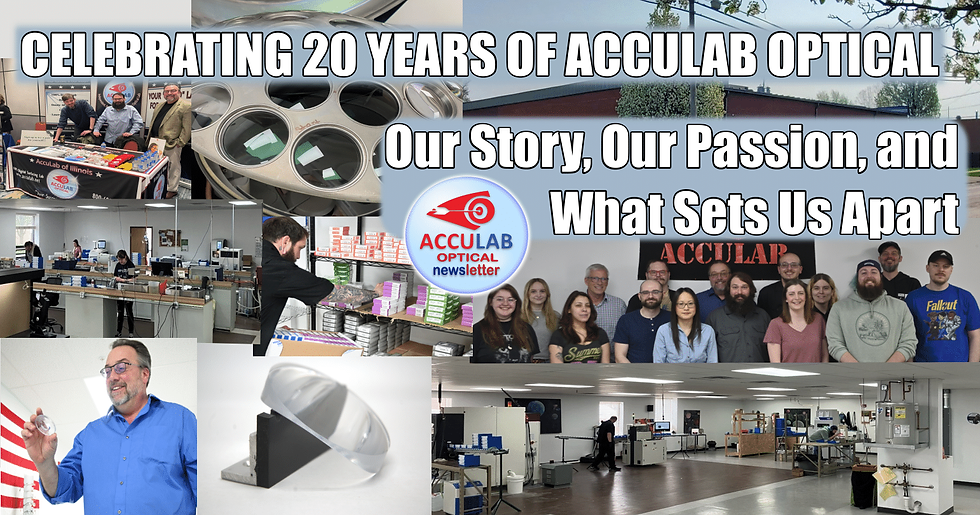Beyond the Color Wheel: The Subtle Art of Tinting Eyeglass Lenses
- AccuLab Optical

- Aug 29
- 3 min read
Updated: Sep 4
By Jon J. Trutt
Published: 8/29/2025

Tinting eyeglass lenses might seem as simple as picking a color from a vending machine, but anyone who’s worked in lens tinting knows it’s far from that. The process is both a science and an art, requiring skill, experience, and a careful understanding of the wearer’s needs.
Why Tinting Is an Art
Color matching is subjective. What looks like the perfect shade under one light might appear completely different in another. Patients often come in with very specific ideas of how they want their lenses to look, and it’s the job of a skilled lens technician to translate that vision into reality. This is why tinting is not just about applying a color; it’s about creating a custom look that meets expectations.
The Tinting Process
Tinting is a similar process to dying Easter eggs. It starts with selecting the right dye for the lens material. Lenses are carefully placed in a heated dye bath, where the dye penetrates the lens surface evenly. The longer a lens stays in the bath, the darker the tint becomes. After reaching the desired color, lenses are rinsed, dried, and polished to ensure a smooth, consistent finish.
Several factors influence the final result: the type of lens material, the thickness of the lens, and even subtle differences in the dye batch. That’s why a skilled tinting technician doesn’t rely solely on percentages or guesswork. They adjust the process based on experience and careful observation.
When it comes to tinted eyeglass lenses, there are several options available, each designed with a specific purpose in mind. Understanding the differences can help patients make informed decisions that balance function, comfort, and style.
Solid Tints – These lenses are evenly tinted across the entire surface, offering consistent shade and glare reduction. They are commonly used for everyday sunglasses and can be customized in a wide range of colors and darkness levels.
Gradient Tints – These lenses transition from a darker shade at the top to a lighter shade at the bottom. This design provides some overhead light blocking while keeping the lower portion clearer for activities like reading or driving.
Double Gradient Tints – These feature a darker tint at both the top and bottom of the lens, with a lighter band across the middle. They’re ideal for outdoor activities on water or snow, where light reflects from multiple directions.
Therapeutic Tints – These specialty tints are designed to address visual comfort and certain medical needs. For example, blue-blocking tints can reduce digital eye strain, while specific colors (such as Avulux® or FL-41) are prescribed to help with light sensitivity, migraines, or other visual conditions.
When to Recommend Each
Solid Tints – Best for patients wanting classic sunglasses or consistent shade for bright outdoor environments.
Gradient Tints – Great for drivers or anyone who wants to block the sun without darkening the entire field of view.
Double Gradient Tints – Ideal for outdoor enthusiasts who spend time around reflective surfaces like water, sand, or snow.
Therapeutic Tints – Recommended for patients with medical or visual comfort needs, such as light sensitivity, migraines, or digital strain.

By matching the right tint type to the patient’s lifestyle, eye care professionals can enhance both comfort and visual performance while also offering stylish, customized lens options.
The Importance of a Reference
One of the best ways to ensure a patient gets exactly what they want is to provide the lab with a reference. This could be a demo lens or even a photograph. A reference gives the technician a concrete example to match, making it far easier to meet the patient’s expectations than relying on numbers or descriptions alone.
Why Levels Work Better Than Percentages
Many opticians are tempted to order tints by percentages, like “10% blue.” In practice, this can be confusing because percentages can vary in appearance depending on lens material and lighting. A more reliable system is ordering by levels:
Level 1 – Lightest tint, subtle enough for indoor and outdoor use.
Level 2 – Medium tint, good for outdoor conditions.
Level 3 – Darkest tint, reduces overall brightness and glare.
This approach simplifies communication with the lab and ensures consistency across orders.

Tinting lenses is a delicate balance between precision and artistry. A great tint enhances vision, reduces brightness, and adds a personal touch to eyewear. By understanding the process, providing clear references, and using a level-based ordering system, patients and eye care professionals alike can achieve results that are both beautiful and functional.
Contact AccuLab Optical today if you need a custom tinted lens. We're happy to help!
800-688-3904 or info@acculab.net










Comments